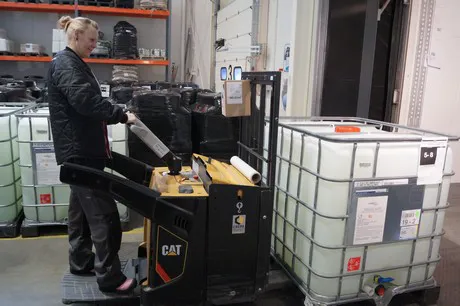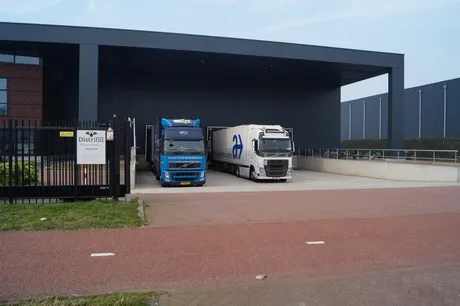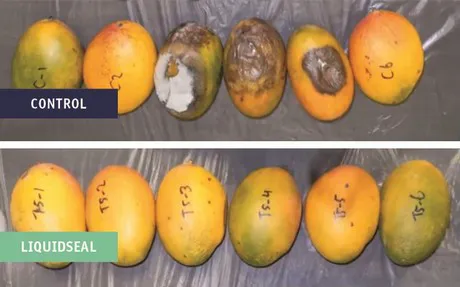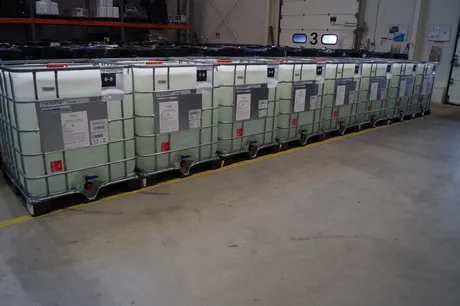Nobody likes to talk about pesticides or packaging, especially consumers. Yet both terms apply to Liquidseal, an extremely thin, liquid packaging created by the Dutch company of the same name, who want to extend the shelf life of perishables to combat product loss. Co-founder Victor Monster: “Without packaging, a lot of products wouldn’t even reach the supermarkets. Liquidseal is an additional cog in the entire supply chain in order to get perishables of high quality to consumers.”

In 2005, the first steps were taken and a recipe was developed to give lily bulbs a longer shelf life. Successes were achieved with other ornamental plant products such as cut roses, carnations and gerberas. In 2016, the step to the fresh produce sector was made. Liquidseal is now applied to avocados, citrus, mangoes and papayas.
Before we go on: how does the product actually work? “We extend the shelf life of perishables. Most products need oxygen to survive. When you completely close off a product like that, which is actually what happens with most regular plastic packaging, the product slowly withers. We also close considerable parts of products off to the open air, but we allow controlled and reduced oxygen. When you apply a wafer-thin layer, you get a breathable packaging that controls the supply of oxygen and the evaporation of water. At the same time, it’s also possible to add pesticides to Liquidseal that are gradually released to combat, for instance, moulds. Because of this, fewer pesticides are needed and losses during and after transport are also reduced.”
“We extend the shelf life of perishables. Most products need oxygen to survive. When you completely close off a product like that, which is actually what happens with most regular plastic packaging, the product slowly withers. We also close considerable parts of products off to the open air, but we allow controlled and reduced oxygen. When you apply a wafer-thin layer, you get a breathable packaging that controls the supply of oxygen and the evaporation of water. At the same time, it’s also possible to add pesticides to Liquidseal that are gradually released to combat, for instance, moulds. Because of this, fewer pesticides are needed and losses during and after transport are also reduced.”
What was the reason for developing Liquidseal? Combating food waste or combating plastic packaging?
“The actual reason was extending shelf life. I’m still surprised by the amount of costly produced food that is thrown out due to decay. Globally, about 40 per cent of produced food is binned. At the time, in 2005, the discussions regarding food waste and packaging wasn’t as important a topic as it is now, but in recent years we’ve also been a part of that. We try to positively contribute to the reduction of plastic, and we expect we can completely remove the current plastic bag packaging in a number of cases, however it won’t be possible in all cases.”

After the introduction in the ornamental plant sector, it took some time before the step towards the fresh produce sector was made. Why did it take so long?
“After the introduction in the ornamental plant sector, we started working on a recipe suitable for tropical fruit with a hard skin quite soon. Tropical fruit is grown far away, so a good shelf life is a necessity. But you’re dealing with European and American legislation and regulations. Our product is in line with the regulations regarding Food Contact Materials, which means all components of Liquidseal are on that list and are therefore deemed safe for consumers. The skin can therefore be eaten without problems; it’s not harmful. Only if you were to eat 500 treated mangoes in one day would it become harmful. But I imagine eating that many mangoes in one day would be a bad idea to begin with.”
How did consumers respond in the fresh produce sector?
“Consumers have negative associations with the term packaging, and pesticides don’t have the best associations either. Liquidseal wasn’t well known, and as the saying goes: unknown, unloved. We therefore had extensive consumer research done by an external agency in the run-up to the introduction. Consumers were informed about the product’s characteristics, and their opinions were considered during the development process. Consumers have to be made aware of the fact that without packaging, a lot of (tropical) fruit wouldn’t even make it to the supermarket. Steps have to be taken if consumers want to be able to eat high quality and flavourful tropical fruit every day. Initially, there’s resistance against the invisible layer, but as soon as people know it’s biodegradable and has important organic certifications (including Kiwa Covenant and CAAE Certification), they’ll be on board, and even become proponents.”

Growers, transporters, traders and retailers have to handle the product before it reaches consumers. What does Liquidseal mean to them?
“Growers have to work with our product first. Liquidseal can be applied by spraying it on the product after the harvest with no major investments, because growers often already have the equipment for spraying or submerging the product. The added value of our product, however, only becomes clear later in the logistical process. Traders and retailers receive a qualitatively good product with an improved shelf life. Because of that, there’s less product loss, they can choose cheaper and environmentally friendlier sea cargo, and the moment of sale is extended.”
Could the product also be harvested later?
“Yes, the product can be harvested less unripe, and once it arrives here, it can continue ripening. A mango in the tropics is much more flavourful than the fruit you can buy here, after all. Harvesting later is to the benefit of flavour and sugar content of the fruit.”

These are all advantages, are there challenges as well?
“Our challenge is to convince all parties in the supply chain that the additional charge growers ask for the treatment with Liquidseal is worth the investment. When customers request a container of citrus and that container contains a lot of lost product, costs to sort the content can easily be ten times higher than the cost of treating that one container with Liquidseal.”
“We therefore cannot complain about attention from the fresh produce sector, but we remain cautious. We want to do things one step at a time, and we advise our users to do the same. Growers harvesting later is an option, for example, but with a market introduction we actually mean not to change anything in the current method of working other than applying Liquidseal.”
“In the meantime, new companies arrive in the sector with ‘interesting’ innovations every day. It therefore makes sense that companies want to test the products first. The same is true for our product. People want to see that it works first, by monitoring treated and untreated avocados for a month, for example, to see when decay starts to set in.”
“As soon as people are convinced, we can start supplying. Our production capacity is definitely no restriction. Our restriction is found more in the personal support we want to give. After all, the product has to be used in the right manner. Even when Liquidseal is used, it will always be important to treat the transport well and to have conditioned transport.”
In how many countries is Liquidseal now used?
“We currently sell Liquidseal in 20 countries, and a few more are added every few months. Turkey and South Africa, for instance, were recently added to our list. It’s a continual process, one that means you’re constantly dealing with different types of legislations and regulations per country. When we received approval to apply it to fresh produce with a firm skin, we opened up the champagne. However, we were then surprised y the legislation and regulation that is different in each country, even within Europe. But looking at it differently, that does mean there are more reasons to celebrate and drink champagne because of that. But seriously, we have a full-time Compliance Officer because of those legislations and regulations, to take care of registrations, to monitor and guard them.”
Has the ultimate recipe now been discovered, and what is your next goal?
“The ultimate recipe is never finished, there will always be room for improvement. Our R&D is now working on an edible packaging. That would also make Liquidseal suitable for soft fruit and greenhouse vegetables, for instance. Our goal is to have this edible packaging ready for market introduction in 2020. This packaging will also meet all requirements and legislation and regulations, so we’re now just waiting for registration and approval. It’s a formality, but one that takes time.”
Voor meer informatie
Liquidseal
Schuttersveld 9
2316 XG Leiden
Nederland
T 071 3014314
info@liquidseal.nl
www.liquidseal.nl
